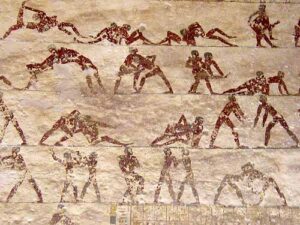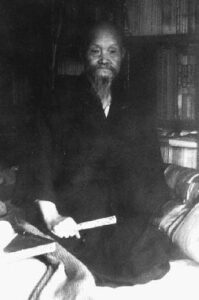A Brief History of Ju-Jitsu and Its Connection to Kobukai Ju-Jitsu
Grappling as a form of self defense has existed for thousands of years. There are pictures of grappling fighting styles in Egyptian tombs dating from 2300 B.C.

Beni Hasan Tomb – Egypt
It is thought that Ju-Jitsu, as a formalized fighting methodology began in Japan around 880 A.D. A man named Teijun Fujiwara learned grappling and striking techniques from the Chinese and developed them to fit the battlefield needs of Japan. He taught these techniques to the warriors of the Minamoto clan.
Yoshitoki Minamoto
From these techniques developed two distinct methods of Ju-Jitsu. The first eventually came to be known as Aiki-Jujutsu. This type of Ju-Jitsu was for use by the military elite and members of the royal court, mainly while inside the castle or compound. The other method, called Jujutsu, Yawara, Kogusoku and other names was used by regular foot soldiers and was a rougher style. Both methods utilized the weapons of the day, along with unarmed techniques.
By the 1400’s there were several styles of Jujutsu taught in Japan. The ones formed before the mid 19th century that survive today are referred to as Koryu, roughly meaning “ancient style.” Some of the original Koryu were Takenouchi-Ryu, Yoshin-Ryu, Araki-Ryu, Tatsumi-Ryu, and Sekiguchi-Ryu. By the early 1800’s there were over 700 ryu documented in Japan. Ju-Jitsu continues to develop, as it always has and new Ryu continue to be formed.
Kobukai Ju-Jitsu has its roots in Japanese Jujutsu and Aiki Jujutsu. Aiki Jujutsu was passed down from the Minamoto clan to the Takeda clan of the Aizu region of Japan. In the 1840’s one Soemon Takeda was teaching Aiki Jujutsu to a retainer, Tanomo Saigo. Saigo in turn taught these techniques to Sokaku Takeda. Sokaku “re-invented” the Aiki Jujutsu techniques to fit the changed battlefield of 19th century Japan, while retaining many ancient techniques and forms. For our JuJitsu style, a sensei named Yoshida Kotaro was important, as he was a master of Daito-Ryu Aikijutsu and Yanagi-Ryu Aikijutsu.

Sokaku Takeda
Yoshida Kotaro
He passed on Aikijutsu techniques to Richard Kim. Richard Kim moved to the United States where he taught Aiki Jujutsu techniques to Raymond “Duke” Moore. Duke Moore in turn passed on these methods to Jerry Kunzman, who gave them to Daniel Ustie, who taught them to Russ St. Hilaire. Sensei St. Hilaire has also studied various
forms of Aikijujutsu.
Kobukai Ju-Jitsu has roots in other Jujutsu styles too. In the late 1800’s the Japanese began to leave Japan and travel to Hawaii in order to work on plantations and have a chance at buying land. Among those Japanese were several Jujutsu teachers. One was a Yoshin-Ryu Jujutsu teacher named Kichimatsu Tanaka.
Yoshimitsu Tanaka
Tanaka had his dojo in Hilo, Hawaii. His top student was Seishiro Okazaki. Okazaki established himself by taking challenge matches against boxers and defeating them with Jujutsu. Okazaki’s school, the Kodenkan was in Honolulu, Hawaii.

Henry Seishiro Okazaki
Sensei Okazaki & Sig Kufferath
He called his style, which was a combination of several ryu he had studied, Danzan-Ryu. He passed on his system of Jujutsu to Sig Kufferath, an instructor of Sensei St. Hilaire. Sensei St. Hilaire is currently ranked Sandan (3rd dan) in this form of Jujitsu, and is certified in this Ryu’s healing arts. One other student of Okazaki was Raymond Law. After receiving his blackbelt, Ray Law returned to California from Hawaii and opened a Dojo in the San Francisco area.

Ray Law
One of Law’s students was Raymond “Duke” Moore. Duke Moore studied many martial art styles in his lifetime, because he felt that the “tradition arts”, those solely interested in preserving traditional techniques, were not well suited for modern self-defense needs. Starting in 1940 with Ray Law, he continued his martial art studies
with George Yoshida (Judo), Kiyose Nakae (Kito-Ryu Jujutsu), Mas Oyama (Kyokushin Karate), Richard Kim (Aikijutsu), and others. Having earned several blackbelts over two decades, he began to piece together the best of what he knew into a Self Defense form that came to be known as ZenBudo-Ryu Aikijujitsu.

Duke Moore (left front),
Jerry Kunzman (right front)
This system was passed onto Jerry Kunzman, then Daniel Ustie, then to Sensei St. Hilaire. Sensei St. Hilaire is currently ranked Shichidan (7th dan) in this form of Jujitsu. Sensei St. Hilaire has also studied other Ryu of Jujitsu and Military Combatives over the past 30+ years.
THE KOBUKAI DOJO
After twenty five years of studying the methods of Jujitsu, Sensei St. Hilaire put together the best self defense techniques he had learned from various forms of Ju-Jitsu, Aikijutsu, and Military Combatives.

Shihan Russ St. Hilaire
He formed the Kobukai Dojo in 1993. Since that time the Kobukai dojo has developed many students to the Blackbelt level, and a few to instructor level.
Kobukai Jujitsu is a synthesis of Jujutsu and Aikijutsu techniques which have been integrated into a comprehensive self defense system, taught in a traditional Japanese atmosphere, but using modern combatoriented training methodologies.
The catalog of techniques include Atemi (striking), Hazushi (escapes), Nage Waza (throwing techniques), Ne Waza (ground defense and offense techniques), Goshin Waza (self defense techniques), Aikijutsu (self defense using aiki priciples), and Weapon defense (against pistol, club and knife attacks).
The primary focus of the Kobukai Dojo is teaching Self Defense. Although we sometimes utilize sport-type training activities such as Judo Randori and Newaza, it is solely for training. And, although many of our students choose to compete in grappling and other tournaments or contests, this is not the goal of our training.
The Kobukai Dojo teaches its students to avoid physical confrontation at all costs, but when unable to escape to utilize all their Jujitsu knowledge to protect themselves and others.
